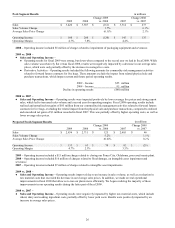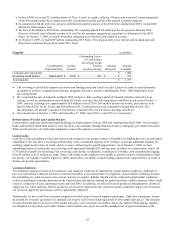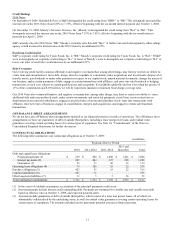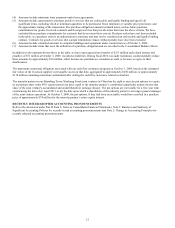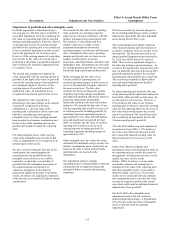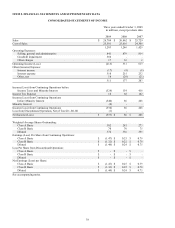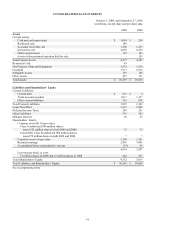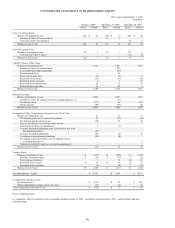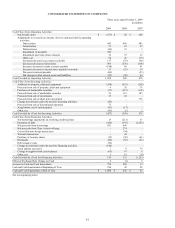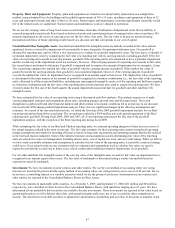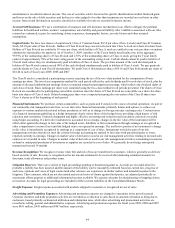Tyson Foods 2009 Annual Report Download - page 35
Download and view the complete annual report
Please find page 35 of the 2009 Tyson Foods annual report below. You can navigate through the pages in the report by either clicking on the pages listed below, or by using the keyword search tool below to find specific information within the annual report.
35
Description
Judgments and Uncertainties
Effect if Actual Results Differ From
Assumptions
Impairment of goodwill and other intangible assets
Goodwill impairment is determined using a
two-step process. The first step is to identify if
a potential impairment exists by comparing the
fair value of a reporting unit with its carrying
amount, including goodwill. If the fair value of
a reporting unit exceeds its carrying amount,
goodwill of the reporting unit is not considered
to have a potential impairment and the second
step of the impairment test is not necessary.
However, if the carrying amount of a reporting
unit exceeds its fair value, the second step is
performed to determine if goodwill is impaired
and to measure the amount of impairment loss
to recognize, if any.
The second step compares the implied fair
value of goodwill with the carrying amount of
goodwill. If the implied fair value of goodwill
exceeds the carrying amount, then goodwill is
not considered impaired. However, if the
carrying amount of goodwill exceeds the
implied fair value, an impairment loss is
recognized in an amount equal to that excess.
The implied fair value of goodwill is
determined in the same manner as the amount
of goodwill recognized in a business
combination (i.e., the fair value of the
reporting unit is allocated to all the assets and
liabilities, including any unrecognized
intangible assets, as if the reporting unit had
been acquired in a business combination and
the fair value of the reporting unit was the
purchase price paid to acquire the reporting
unit).
For other intangible assets, if the carrying
value of the intangible asset exceeds its fair
value, an impairment loss is recognized in an
amount equal to that excess.
We have elected to make the first day of the
fourth quarter the annual impairment
assessment date for goodwill and other
intangible assets. However, we could be
required to evaluate the recoverability of
goodwill and other intangible assets prior to
the required annual assessment if we
experience disruptions to the business,
unexpected significant declines in operating
results, divestiture of a significant component
of the business or a sustained decline in market
capitalization.
We estimate the fair value of our reporting
units, generally our operating segments,
using various valuation techniques, with the
primary technique being a discounted cash
flow analysis. A discounted cash flow
analysis requires us to make various
judgmental assumptions about sales,
operating margins, growth rates and discount
rates. Assumptions about sales, operating
margins and growth rates are based on our
budgets, business plans, economic
projections, anticipated future cash flows and
marketplace data. Assumptions are also made
for varying perpetual growth rates for periods
beyond the long-term business plan period.
While estimating the fair value of our
Chicken and Beef reporting units, we
assumed operating margins in future years in
excess of the annualized margins realized in
the most current year. The fair value
estimates for these reporting units assume
normalized operating margin assumptions
and improved operating efficiencies based on
long-term expectations and margins
historically realized in the beef and chicken
industries. We estimate the fair value of our
Chicken reporting unit would be in excess of
its carrying amount, including goodwill, by
sustaining long-term operating margins of
approximately 5.0%. After the $560 million
non-cash impairment recognized in fiscal
2009, we estimate the fair value of our Beef
reporting unit would be in excess of its
carrying amount, including goodwill, by
sustaining long-term operating margins of
approximately 2.0%.
Other intangible asset fair values have been
calculated for trademarks using a royalty rate
method. Assumptions about royalty rates are
based on the rates at which similar brands
and trademarks are licensed in the
marketplace.
Our impairment analysis contains
uncertainties due to uncontrollable events that
could positively or negatively impact the
anticipated future economic and operating
conditions.
We have not made any material changes in
the accounting methodology used to evaluate
impairment of goodwill and other intangible
assets during the last three years.
The recent disruptions in global credit and
other financial markets and deterioration of
economic conditions led to an increase in our
discount rate. The discount rate used in our
annual goodwill impairment test increased to
10.1% in fiscal 2009 from 9.3% in fiscal
2008. There were no significant changes in
the other key estimates and assumptions. As
a result of the significantly increased discount
rate, we failed the first step of the fiscal 2009
goodwill impairment analysis for our Beef
reporting unit and performed the second step.
The second step resulted in a $560 million
non-cash partial impairment of the Beef
reporting unit's goodwill.
No other reporting units failed the first step
of the annual goodwill impairment analysis in
fiscal 2009, 2008 and 2007 and therefore, the
second step was not necessary. However, a
10% decline in fair value of our Chicken
reporting unit would have caused the carrying
value for this reporting unit to be in excess of
fair value which would require the second
step to be performed. The second step could
have resulted in an impairment loss for the
Chicken reporting unit's goodwill.
After the $560 million non-cash impairment
recognized in fiscal 2009, a 17% decline in
fair value of our Beef reporting unit would
have caused the adjusted carrying value for
this reporting unit to be in excess of fair
value.
Some of the inherent estimates and
assumptions used in determining fair value of
the reporting units are outside the control of
management, including interest rates, cost of
capital, tax rates, and our credit
ratings. While we believe we have made
reasonable estimates and assumptions to
calculate the fair value of the reporting units
and other intangible assets, it is possible a
material change could occur. If our actual
results are not consistent with our estimates
and assumptions used to calculate fair value,
we may be required to perform the second
step which could result in additional material
impairments of our goodwill.
Our fiscal 2009 other intangible asset
impairment analysis did not result in a
material impairment charge. A hypothetical
10% decrease in the fair value of intangible
assets would not result in a material
impairment.



